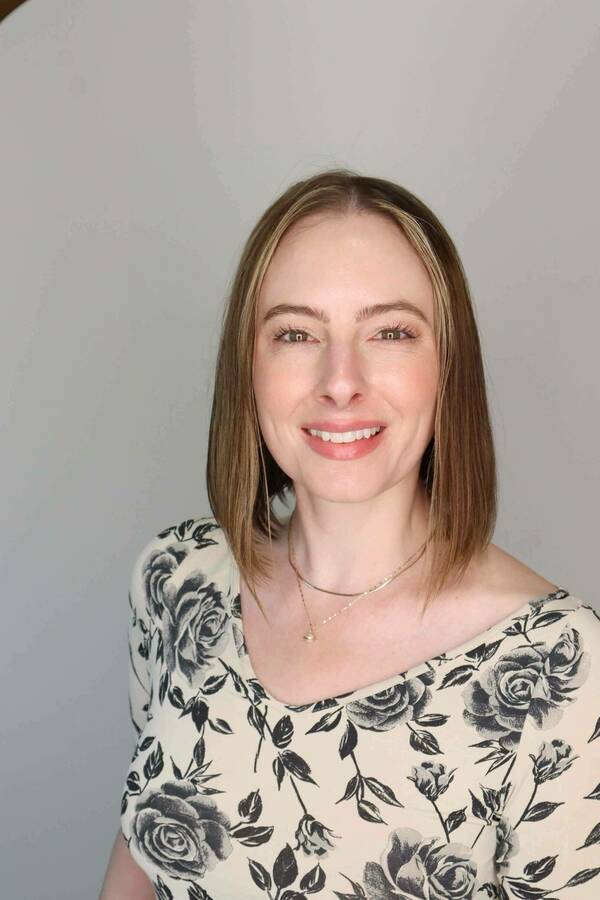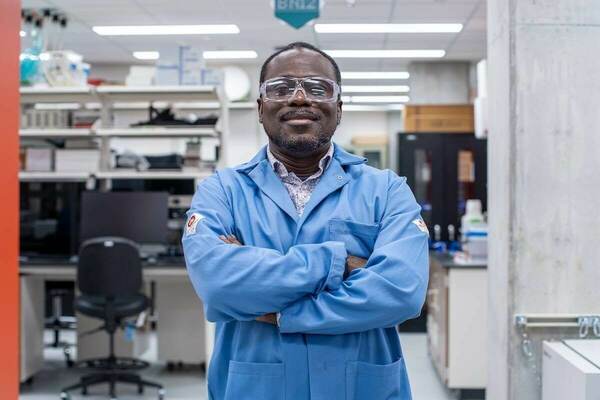Expanding endometriosis research: Postdoctoral researcher Ell Handy focuses on women’s health
Ell Handy, a postdoctoral researcher at the University of Notre Dame with the Bioengineering Life Sciences Initiative (BELS), seeks to uncover new ways to diagnose and treat endometriosis, a debilitating gynecological disorder affecting approximately 10 million women worldwide.

Handy’s research, which merges doctoral work in synthetic organic chemistry with biomedical research, may help close the gap in women's health care. Handy works in the laboratory of Mariko Morimoto, Huisking Foundation Assistant Professor in the Department of Chemistry and Biochemistry.
“Taking the chemistry from the bench to the patient and doing something that was not solely esoteric... that was important to me,” said Handy, who is the University’s first postdoctoral fellow for BELS, as well as a Society of Science Fellow in the College of Science.
Handy earned a doctorate degree at Stanford and an undergraduate degree at the University of California, Berkeley, and studied a class of small molecules that mimic sugars. Carbohydrates like these play an essential role in disease progression both in cancer and infectious diseases, and the principles can also be applied to endometriosis. The condition causes tissue similar to that found in the uterus to grow outside of the organ and onto ovaries, fallopian tubes and other areas within the abdomen, causing pain and leading to infertility.
Endometriosis can take an average of seven years to diagnose, Handy said, and there is no diagnostic test for it except for surgery to remove tissue and determine its pathology. Before coming to Notre Dame, both Handy and Morimoto worked in the same laboratory as they sought to characterize unique glycan profiles —which are detailed analyses of the types of the carbohydrates attached to a protein, cell, or other molecule—associated with endometriosis.
By analyzing blood and serum samples from patients with endometriosis, Handy said they hope to identify patterns that could serve as diagnostic biomarkers, which can help detect disease. They are supported in part by the Feinstein Institutes for Medical Research, which is providing additional patient cell samples.
“So we’re not only interested in looking at blood and serum as a potential diagnostic, but looking at the whole cell as well to see... how they present, and how they evolve over time, as the disease evolves as well,” Handy said.
A roundabout path to chemistry
Though science has become Handy’s career, their path was unconventional. Leaving their small town outside of Richmond, Virginia at 18 for New York City, they were unsure of their path until finding unexpected inspiration at the American Museum of Natural History. Handy visited frequently once becoming a New York State citizen, where they took advantage of the free admission.
“It’s a magical place, and I loved going as much as I could,” Handy said, adding that they initially studied fashion design and still enjoy designing and sewing their own unique outfits. Their curiosity about natural history even led them to join the New York Paleontological Society.
“It wasn’t until that point that it really sparked in me that, hey, I love science. I could do this. There are people that do this all the time. There are scientists out there,” Handy said. “It really never occurred to me. I just didn’t have that environment growing up that would really encourage me to enter a hard STEM field.”
Determined to pursue this newfound interest, Handy enrolled in a community college in northern California, and worked three jobs. While they initially planned to study biology, chemistry became a passion because of its intricacy and complexity, and potential to solve real-world problems. Soon, Handy’s interest became so apparent to chemistry professors that they encouraged Handy to apply to the College of Chemistry at the University of California, Berkeley, where Handy was accepted.
"We are excited to partner with the College of Science to support Dr. Handy's exciting and important research,” said Paul Bohn, Arthur J. Schmitt Professor of Chemistry and Biochemistry, and the inaugural director of BELS. “They are pursuing just the kind of multidisciplinary research that improves people's lives and fulfills the mission of the Bioengineering & Life Sciences Initiative. We look forward to supporting similarly excellent postdoctoral scholars in the years to come."
Finding a mentor and a mission
Handy’s decision to pursue a postdoctoral position at Notre Dame was driven by both personal connections and institutional resources. Morimoto, Handy’s former benchmate at Stanford, played a pivotal role in their decision.
“She was actually the first female mentor that I had had in the field of chemistry,” Handy said. “Although I learned a lot from [male mentors], it was completely different learning from her — getting the patience and understanding, and also respect and curiosity,” Handy said. “I felt like she really had the ability to push me to be the best kind of scientist that I could be.”
But it wasn’t only mentorship that drew Handy to Notre Dame. Cross-university collaborations also piqued their interest, like the Harper Cancer Research Institute and research cores including the Mass Spectrometry and Proteomics Facility and the Fluorescence Assisted Cell Sorting Core Facility. Additionally, the Notre Dame IDEA Center, which supports student innovation, stood out to Handy.
“Not a lot of universities will invest in their students like that. And that’s something that I find really valuable,” Handy said.
The BELS initiative, however, is their primary affiliation, and as the first fully-funded postdoctoral researcher in the initiative, they have dived in and are passionate about continuing their research.
“I am really excited about the initiative, and how Notre Dame is investing in expanding its scientific studies in this area,” Handy said.
Originally published by at science.nd.edu on April 21, 2025.
Latest Research
- Putting 10 pounds in a five-pound bag: a graduating senior reflects on majoring in global affairs…
- As the Harper Cancer Research Institute’s first-ever associate director for translational research, Herman Sintim is working to turn discoveries into new tools for fighting cancerSintim brings a wealth of expertise in both basic science and entrepreneurship to his new role.
- Fall 2025 SAI Graduate Fellowship Program: Applications Open NowNotre Dame Scientific Artificial Intelligence (SAI) Graduate Fellowship The Notre Dame Scientific Artificial Intelligence (SAI) Initiative is excited to announce a semester-long Fall 2025 fellowship program for PhD students seeking to newly…
- Merlin Bruening named 2025 Outstanding Teacher in Notre Dame College of EngineeringMerlin Bruening, the Donald and Susan Rice Professor of Engineering in the Department of Chemical and Biomolecular Engineering, has won the 2025 Outstanding Teacher Award in the Notre Dame College of Engineering.
- Notre Dame Research, Athletics address challenges of ACL tears, sleep loss, and stress in new joint research projectsNotre Dame Research and Athletics have awarded three research teams the first-ever Human Performance & Wellness Research Grants. The grants will provide funding to support exceptional research projects that contribute meaningfully to fields related to the health, well-being, and performance of…
- ND Expert Arun Agrawal: The Holy Father’s vision in Laudato Si’ is both a beacon and a cautionArun Agrawal, the Pulte Family Professor of Development Policy at the Keough School of Global Affairs and inaugural director of the Just…












